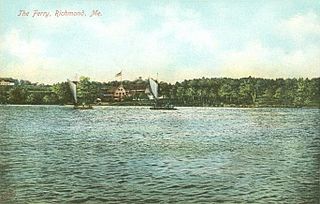
Perkins Township is an unorganized territory in Sagadahoc County, Maine, United States. Originally incorporated as the town of Perkins, it has been uninhabited since being abandoned by the 1940s. The township comprises Swan Island, Little Swan Island and some tidal flats - all within the Kennebec River between the towns of Richmond and Dresden. The Swan Island Historic District comprises most of the township, with 8 buildings, 5 structures and 1,500 acres (610 ha). Some of the buildings date to the 1750s. The district was added to the National Register of Historic Places in 1995. The entire township is now protected as the Steve Powell Wildlife Management Area, and is under the jurisdiction of the Maine Department of Inland Fisheries and Wildlife. Camping, hunting, fishing, and wildlife viewing are permitted between May and October; reservations are required.

Cahill School is a one-room schoolhouse now located in Tupa Park near Minnesota State Highway 100 and Eden Avenue in Edina, Minnesota, United States. It is the oldest remaining building in Edina, and served as a schoolhouse, church, community center, and theater over its 94-years in use. The school continued to be used with its woodstove and outhouse until it closed in 1958. It was moved to its present location from the southeast corner of Cahill Road and West 70th Street in 1970.

Fishing Creek Schoolhouse is a historic school located in the Villas census-designated place, of Lower Township, Cape May County, New Jersey, United States. The schoolhouse was built in 1888 and added to the National Register of Historic Places on March 6, 1980.
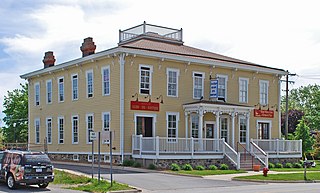
Cherry Hill is an unincorporated community in Canton Township in the U.S. state of Michigan. The community centers along Cherry Hill and Ridge Roads but otherwise has no legally defined boundaries or population statistics. The Cherry Hill Historic District is a primarily residential historic district encompassing the greater part of Cherry Hill. It was listed on the National Register of Historic Places in 2003.

The Greer's Corner School is an historic school in Belmont Corner, Maine. Built in 1908, it is the only surviving one-room schoolhouse in the rural community. It was listed on the National Register of Historic Places in 1991.

The Old School Privy is a historic outhouse in the village of Genoa, Ohio, United States. Constructed in the 1870s, it has the unusual distinction of being both a public toilet and an official historic site.

Strang School District No. 36, or the Strang Public School, is a historic school located in Fillmore County, Nebraska, in the village of Strang. The school is one of the two sites listed on the National Register of Historic Places in the village of Strang. The school building is a small, two-story, brick public schoolhouse, which was built to replace the schoolhouse that was previously located on that site. The schoolhouse was built between 1929 and 1930, and replaced the previous schoolhouse, which burned down in 1928. The schoolhouse still retains all original building materials. The school served high school students from 1930 to 1951, and still functions as a school today, serving grades K–8. The NRHP listing also includes a flagpole located outside the schoolhouse, and five pieces of playground equipment.
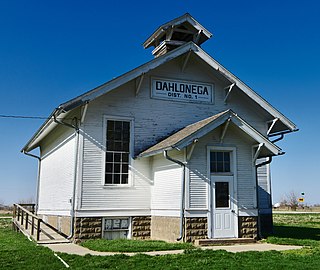
Dahlonega School No. 1 is an historic school building located near Ottumwa, Iowa, United States. It is located in the center of the unincorporated community of Dahlonega. The building was completed in 1921 and served as a school building until 1959. It served as a voting place for the township until 1986. The one-room schoolhouse measures 1,100 square feet (100 m2). The property was listed on the National Register of Historic Places in 2000.

Wallpack Center is an unincorporated community located within Walpack Township, Sussex County, New Jersey, United States. Wallpack Center is located in the Flat Brook Valley 6.7 miles (10.8 km) west of Branchville. Wallpack Center has a post office with ZIP code 07881.
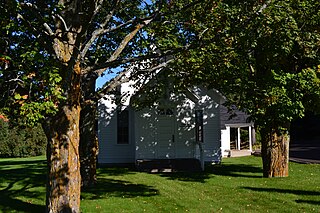
The Bingham District No. 5 Schoolhouse is a school building located at 7171 South Center Highway in Bingham Township, Leelanau County, Michigan. It is now used as the Bingham Township Hall. It was designated a Michigan State Historic Site in 1987 and listed on the National Register of Historic Places in 1991.
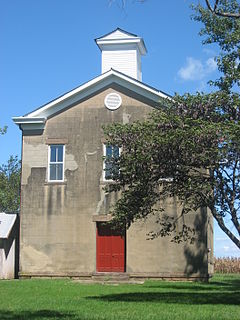
Shiloh College is a historic school building located at 13043 Walnut Street in Shiloh Hill, Illinois.
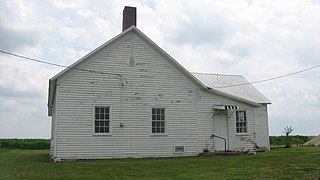
The Clarksburg Schoolhouse was a historic school building located on Clarksburg Road in Clarksburg, Illinois. The school opened circa 1892 and was originally known as Bethel School; it changed its name following the growth of Clarksburg in the ensuing years. The school served as Clarksburg's public primary school for children in the first through eighth grades; students from the school continued their education at Shelbyville's high school. After the school merged into Shelbyville's district in the 1960s, the building became a community center for Clarksburg Township; it served in this capacity until 1998. The building was the only surviving community schoolhouse in the area.

The Madrid Village Schoolhouse is a historic community building on Reeds Mill Road in the center of the disincorporated township of Madrid, Maine. Built c. 1872, it is the least-altered surviving district school building of twelve originally built in the community. In the later years of the 20th century the school was used for town meetings and offices prior to the town's disincorporation in 2000. The building was listed on the National Register of Historic Places in 1995.
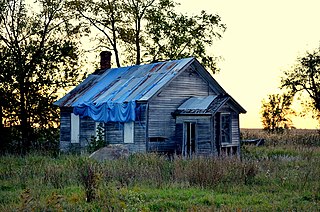
Wilson District No. 7 School, also known as the O'Meara Schoolhouse, is an historic structure located in rural Clinton County, Iowa, United States near the town of Delmar. The one-room school was listed on the National Register of Historic Places in 2004. The listing includes three structures: the former school building and two outhouses.

The Pleasant Grove School is a historic school building located in Logan Township, Peoria County, Illinois, near the community of Eden. The one-room schoolhouse was built in 1856 to educate the children of Pleasant Grove, the name for the surrounding community at the time. The school was built on the same property as the community's church, which has since been demolished, and its cemetery. Local stonemason Joel Lobaugh built the school from locally quarried, rough coursed limestone; his design was utilitarian, with limestone window sills and lintels being the only decorative elements. The school served students until 1945, when all of Logan Township's schools consolidated into a single school in Eden.
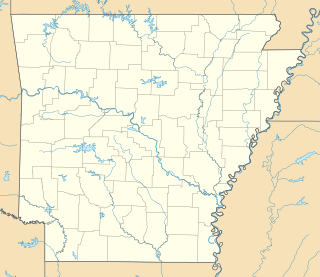
The Liberty Schoolhouse, also known as the Mt. Grove School, is a historic schoolhouse in a remote part of Ozark-St. Francis National Forest in Logan County, Arkansas. It is east of Corley, Arkansas, near the junction of Valentine Spring and Copper Spring Roads. It is a single-story vernacular wood-frame structure, with a gabled roof, weatherboard siding, and a foundation of concrete block piers. It was built in 1897, and was used by the community as both a school and church. It served as a school until 1944, and also hosted civic meetings and social events.

Hoosier Row School is a historic building located southwest of Indianola, Iowa, United States. The property for the one-room schoolhouse was acquired by Sub District No. 4, White Oak Township from Alva P. Keeny and Mary J. Keeny on March 10, 1870. They paid $100 for 1-acre (0.40 ha). The present building was constructed in 1900, and now serves as a community center. It was listed on the National Register of Historic Places in 2011.

Mill Rock School is a historic one-room schoolhouse located south of Baldwin, Iowa, United States. It is one of over 217 limestone structures in Jackson County from the mid-19th century, of which 12 are school buildings. This school building was built in 1869 by Abner Hunt and P.A. Downer. The stone blocks that were used in the construction of this rectangular structure vary somewhat in shape and size, and they were laid in courses. The window sills and lintels are dressed stone. There is a brick chimney on the west elevation, and two entrance doors on the east elevation. Having two entrance doors is unusual for rural Jackson County schools. A name and date stone is located in the east gable.

Highlandville School, also known as Highlandville Village School, is a historic structure located in the unincorporated community of Highlandville, Iowa, United States. It was built in 1911, replacing a 1904 building that was destroyed in a fire. The frame building follows a broad T-plan. The top of the T is a two-room rectangular section capped with a hip roof. A single-room, central projecting gable-front with a belfry forms the T's upright. The front section was used an entryway/coatroom, while the two-room back section housed the classrooms. The frame structure rests on a limestone basement. An entrance ramp replaces the original entrance steps. Two privies, which share the historic designation, are located to the north of the main building. The school was operated independently until 1960, and it closed in 1964. It stands as a reminder of the state of Iowa's determination to educate its citizens, particularly in the rural areas. It is also a unique rural two-room schoolhouse in Winneshiek County. The building was listed on the National Register of Historic Places in 2014.
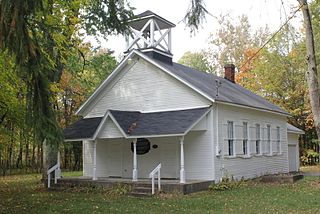
The Olive Township District No. 1 School, also known as the Olive Station School, is a one-room school located at 11611 Stanton Street in Olive Township, Michigan. It is now a private residence. It was listed on the National Register of Historic Places in 1998.























